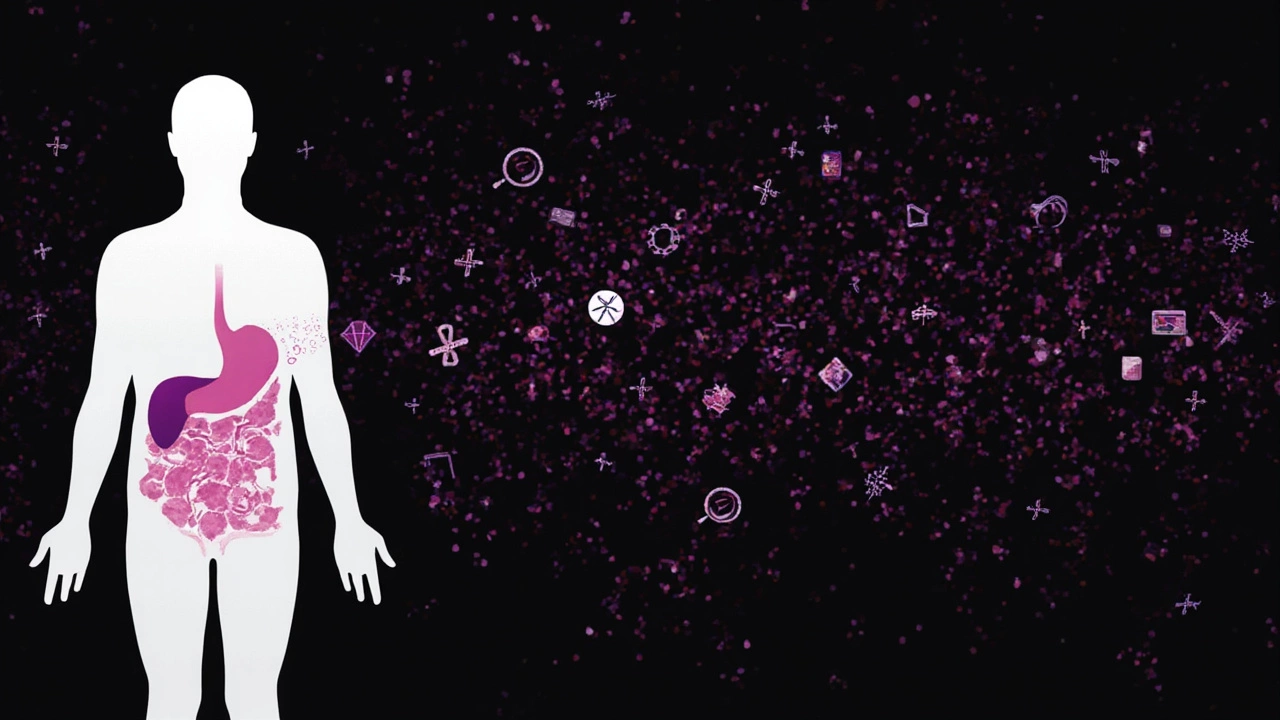
Cancer is a word that sends a chill down anyone's spine, but when you hear about pancreatic cancer, the chill deepens. Often referred to as the fastest killing cancer, pancreatic cancer is notorious for its speed and stealth. Sounds grim, right? But knowing why it's so aggressive might help us find a way to tackle it better.
Pancreatic cancer's rapid progression often makes it hard to catch in the early stages. By the time symptoms appear, it's usually advanced and spreads quickly to other parts of the body. That's why regular check-ups and being aware of the warning signs is key. It seems like a no-brainer, but how often do we skip doctor visits?
One might wonder, why is it so hard to deal with? Well, the pancreas is nestled deep in the abdomen, making early tumors tricky to spot. Plus, this type of cancer is often resistant to typical treatments. It's like trying to hit a moving target—never an easy feat!
- The Rapidity of Pancreatic Cancer
- Early Detection and Warning Signs
- Understanding the Challenges
- Current Treatment Options
- Looking Towards the Future
The Rapidity of Pancreatic Cancer
When it comes to fastest killing cancer, pancreatic cancer often tops the list. It's notorious for how swiftly it operates, leaving patients and doctors alike struggling to keep up. But what exactly makes it such a formidable foe?
The pancreas lies hidden deep in the abdomen. This location can be a big issue because it makes early detection really tough. By the time symptoms become noticeable—often things like jaundice, pain in the abdomen, or unexplained weight loss—the cancer has usually advanced quite far.
The problem doesn’t stop there. Pancreatic cancer tends to spread quickly to nearby organs and tissues, making surgical removal extremely challenging. Surgery is the most effective treatment, but less than 20% of patients are eligible due to late-stage diagnosis.
The Biology Behind the Speed
From a biological standpoint, pancreatic tumors often don't respond well to chemotherapy or radiation. It's like they have their own defense mechanism, making it hard for treatments to be effective. This resistance, along with the speed at which it progresses, is why dealing with this cancer feels like you're racing against time.
| Stage | Survival Rate |
|---|---|
| Localized | 39% |
| Regional | 13% |
| Distant | 3% |
Alarmingly, statistics show that only about 10% of patients survive for five years after a diagnosis. These numbers speak volumes about the urgency needed when addressing pancreatic cancer.
In essence, the speed of pancreatic cancer underscores the vital need for awareness and early detection. Knowing what to look out for and getting regular health checks might just tip the scales in your favor.
Early Detection and Warning Signs
Here's the deal with fastest killing cancer like pancreatic cancer—the sooner you catch it, the better your chances. So, being on the lookout for those early warning signs isn't just smart, it’s crucial. But what exactly should you be watching for?
First off, keep an eye on sudden changes in your body that persist over time. Things like unexplainable weight loss, a new-onset diabetes especially if you have no family history, or any persistent stomach pain that doesn't seem right. Sounds intriguing?
Warning Signs to Watch For
- One of the red flags is jaundice, which is a yellowing of the skin and eyes. It could sneak up on you before you even realize it's there.
- Dark urine and light-colored stools are also indicators that something might be off with your pancreas.
- If you notice a loss of appetite or feel full after just a little bit of food, pay attention. These are common signs people often ignore or attribute to less serious issues.
Why Early Detection is Tough
The pancreas is tough to monitor due to its deep placement in the abdomen. Regular imaging tests like MRIs or CT scans can detect tumors, but aren't usually recommended unless there's a family history or genetic predispositions.
The Role of Check-Ups
Regular health check-ups are more than routine. For those at high risk, they can be lifesaving. Discuss with your doctor the best screening options if pancreatic cancer runs in your family. Many clinics are pushing for smarter blood tests and imaging techniques to improve early detection.
Understanding your body and being proactive about weird changes is like having an edge. It might just make all the difference. Remember, when it comes to tackling aggressive illnesses like pancreatic cancer, knowledge and vigilance are powerful allies.

Understanding the Challenges
Tackling pancreatic cancer head-on is no small feat. This cancer is tough to diagnose early because it lurks silently, popping up only when it's advanced. The pancreas, tucked away in the abdomen, makes it easy for small tumors to hide from the radar of regular scans.
Why It's Hard to Catch Early
Unlike other cancers with clear warning signs, pancreatic cancer symptoms often mimic common digestive issues like bloating or back pain. Most people don't think twice about these symptoms. Sadly, by the time they do, the cancer often has spread.
Treatment Roadblocks
One of the biggest headscratchers for doctors is how resistant to treatment this cancer can be. Chemotherapy, often the go-to for many cancers, doesn't always work well here. Why? The cancer cells in the pancreas seem to have a defiant attitude, often fighting back against treatments or becoming resistant quickly.
Statistics at a Glance
| Factor | Statistic |
|---|---|
| 5-year survival rate | About 11% |
| Median age of diagnosis | 70 years |
As you can imagine, there's a race against time for researchers. They're working tirelessly to find new angles and better treatments. From targeted therapies to immunotherapies, the goal is to turn the tables on this relentless cancer.
In short, while the challenges are plenty, there's hope on the horizon with ongoing research and innovation. Our focus needs to remain on supporting these advancements to make a real difference.
Current Treatment Options
When it comes to battling pancreatic cancer, the treatment options can feel like an uphill struggle. But every bit counts, and understanding what’s available could give patients and their families a sense of hope and direction. As always, catching it early remains critical, but here's a look at the tools doctors, and patients have at their disposal today.
Chemotherapy
One of the go-to treatments is chemotherapy. It aims to kill or slow down the growth of cancer cells. For pancreatic cancer, drugs like Gemcitabine and FOLFIRINOX are common choices. The side effects can be tough—nausea, fatigue, and more—but sometimes it’s the best shot for stopping the cancer from spreading. Combination therapies might even offer better results, although they can be hard on the body.
Radiotherapy
Next on the list is radiotherapy, which uses high-energy rays to target cancer cells. While not always used as a standalone treatment for pancreatic cancer, it can be useful in shrinking tumors before surgery or relieving symptoms if surgery isn’t viable.
Surgery
If the cancer hasn't spread much, surgery is a potential game-changer. The Whipple procedure is the most common type of surgery used for cancers at the head of the pancreas. It’s a complex surgery, involving the removal of a portion of the pancreas along with parts of the stomach and intestines.
Innovative Treatments
Researchers maintain a hopeful outlook with innovative treatments like targeted therapy and immunotherapy. These options focus on helping the body's immune system to detect and fight cancer cells more effectively. Although these options sound promising, they are still under study and not as widely available as the usual treatments.
| Treatment | Effectiveness | Common Side Effects |
|---|---|---|
| Chemotherapy | Moderate | Nausea, fatigue |
| Radiotherapy | Variable | Skin irritation, fatigue |
| Surgery | Potentially high if caught early | Pain, delayed stomach emptying |
| Innovative Treatments | Under research | Varies widely |
The journey through cancer treatment is far from easy, and it’s crucial to have a good support system. From doctors to loved ones, making informed decisions about treatment can make a significant difference in managing this aggressive disease. With ongoing advancements, there's hope that these options will continue to improve, hopefully leading to better survival rates in the future.

Looking Towards the Future
When it comes to dealing with pancreatic cancer, there's hope on the horizon. Researchers are working tirelessly to uncover better ways to diagnose and treat this challenging disease. It's kind of like solving a complex puzzle, and every piece of research is a step closer to victory.
Advancements in Early Detection
Early detection is a game-changer for any cancer, and pancreatic cancer is no exception. Scientists are exploring biomarkers that can be detected through blood tests. Imagine the difference if we could catch this cancer before it spreads!
Innovative Treatments in Development
Treatment options are also seeing new developments. From immunotherapy, which boosts the body's own defenses to target cancer cells, to personalized medicine that tailors treatment based on a patient's genetic makeup, innovations abound. It's all about finding a treatment that works effectively for each person.
Hope in Numbers
According to recent stats, a 10% increase in funding for pancreatic cancer research has led to a promising rise in clinical trials. More trials mean more opportunities to discover breakthroughs, offering hope to many.
The Role of Technology
Technology is another ally in this battle. With AI and machine learning, doctors can now analyze patterns in symptoms and predict outcomes with greater accuracy. It's like having a crystal ball that's grounded in science.
While challenges remain, the movement towards greater awareness, improved early detection, and innovative treatments shines a light on what's possible. It might take time, but with continued efforts, there’s a real possibility of reducing the impact of this fastest killing cancer.

Write a comment